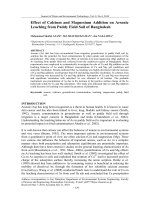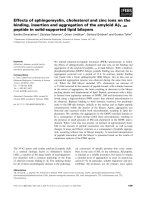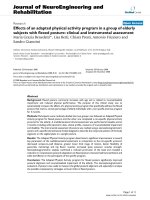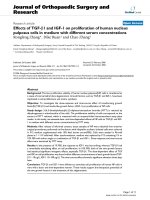effects of potassium calcium and magnesium ratios in soil on nutrient uptake by pummelo
Bạn đang xem bản rút gọn của tài liệu. Xem và tải ngay bản đầy đủ của tài liệu tại đây (367.59 KB, 6 trang )
<span class='text_page_counter'>(1)</span><div class='page_container' data-page=1>
<b>EFFECTS OF POTASSIUM, CALCIUM </b>
<b>AND MAGNESIUM RATIOS IN SOIL </b>
<i><b>ON NUTRIENT UPTAKE BY PUMMELO (Citrus maxima Merr.)</b></i>
<b>Hien Huu Nguyen (1), Somsak Maneepong (2), Thanh Cong Nguyen (1)</b>
<i>1 </i>
<i>School of Agriculture and Natural Resource, </i>
<i>Vinh University, Nghe An, Vietnam </i>
<i>2 </i>
<i>School of Agricultural Technology, Walailak University, </i>
<i>Nakhon Si Thammarat, Thailand</i>
Received on 30/6/2020, accepted for publication on 26/9/2020
<b>Abstract: Potassium (K), calcium (Ca), and magnesium (Mg) are important </b>
nutrients for the pummelo’s growth and productivity. However, these nutrients are
strongly antagonistic to each other. This study aims to examine the effects of different K,
Ca, and Mg ratios in soil on nutrient uptake of pummelo plant. Soil samples were
collected under pummelo canopies at a depth of 0 cm to 20 cm. Leaf samples of 3 to 5
month old were obtained from the same trees. The soil’s chemical properties and nutrient
concentrations in the leaves were determined. The results showed that the P uptake was
inhibited by a high Ca concentration in soil. High K/Mg ratio in soil (0.52 ± 0.27)
positively affected on K uptake. Low K/Mg ratios in soil (0.42 ± 0.20) negatively
affected on K uptake, although exchangeable K in soil was much higher than optimum
ranges. The K/Ca mole ratio in the leaves was higher than that in the soil; therefore, the
uptake of K was better than that of Ca, despite the lower concentration of K in the soil.
Moreover, the uptake of K was better than that of Mg, because the K/Mg ratio in the
leaves higher than that in the soil. Low exchangeable Ca negatively affected on Ca
uptake, although Ca/Mg mole ratio in soil was high (2.77 ± 1.18).
<b>Keywords: Nutrient uptake; nutrition; Pummelo; cation ratios. </b>
<b>1. Introduction </b>
<i>Pummelo (Citrus maxima Merr.) is the biggest fruit of citrus species and high </i>
yield like other citrus. It requires larger amounts of K, Ca and Mg for growth and
productivity. According to Maneepong, the quantities of K, Ca and Mg which required
for fruit growth were 3005, 1506, and 228 mg/fruit, respectively [9]. However, the
nutrient uptake processes of K, Mg, and Ca are strongly antagonistic resulting in a
deficiency of the depressed nutrient [14]. A deficiency of one element could imply a
relative or absolute excess of the others resulting in an imbalance for the plants [3]. A
sufficient Ca concentration in soil or nutrient solution is important; however, major
cations frequently interfere with Ca uptake [1]. Magnesium may strongly modify the
uptake of Ca and K, whereas K and Ca can restrict the uptake and translocation of Mg
from the roots to the upper plant parts [11]. On the other hand, ability of nutrient uptake
does not depend only on its concentration in the soil, because the mobility of each
nutrient into plant root is different.
The optimum K, Ca, and Mg for pummelo growth in soil and nutrient
concentrations in leaves were recommended by Maneepong [9].
</div>
<span class='text_page_counter'>(2)</span><div class='page_container' data-page=2>
However, the effects of K, Ca, and Mg ratios in soil on their uptake were
ambiguous. Hence, the present study aims to examine the effects of K, Ca and Mg ratios
in soil on nutrient uptake.
<b>2. Materials and Methods </b>
The research was conducted from 2015 to 2017. Two representative pummelo
orchards in Pakpanang District (latitude 80 31’ 0749’’ N longitude 1000 12’ 05516’’ E) and
Khanom District (latitude 90 21’ 1369’’ N longitude 990 79’ 0178’’ E), Nakhon Si
Thammarat Province, Thailand were selected for this study. The Tuptim Sayam and
Thong Dee cultivars were selected. Most of the pummelo were planted using air-layering
stocks in 1997. Some plants that were replanted later were not included in this study.
Thirty pummelo trees were selected, and soil samples were collected from 4 positions
directly beneath the canopy of each tree between 0 and 20 cm depth by a sampling tube.
The samples were mixed, air-dried, ground then sieved through a 2 mm screen. Soil pH
and electrical conductivity (EC) were measured using 1:2.5 and 1:5 of soil: water ratios,
respectively. EC at the saturated point (ECe) was estimated by multiplying the EC by 6
[12]. Available P was extracted by 0.03 M NH4F in 0.10 M HCl (Bray II solution), and
its concentration was analyzed by the molybdenum blue method. Exchangeable K, Ca
and Mg were extracted with 1 M NH4OAc at pH 7.0. Concentration of K was analyzed
by a flame photometer. Concentrations of Ca and Mg were analyzed by an atomic
absorption spectrophotometer (AAS) [6, 7].
Three to five-month-old pummelo leaves were sampled from 3rd or 4th position of
newly flush and non-fruiting twig on the outer canopy. Thirty pummelo trees were
selected, and 12 to 16 leaves from each tree were collected. The samples were dried at
65˚C, ground, passed through 1 mm sieve. Nitrogen was analyzed by the Kjeldahl
method. The samples were digested with 2:1 mixed of HNO3: HClO4 for P, K, Ca and
Mg analysis. The concentration of P was analyzed using the vanadomolybdate method.
Concentration of K was analyzed by a flame photometer. Concentrations of Ca and Mg
were analyzed by AAS [13].
<b>3. Results and Discussion </b>
</div>
<span class='text_page_counter'>(3)</span><div class='page_container' data-page=3>
sufficient for pummelo. However, these nutrients are strongly antagonistic to each other.
High Mg concentration either in soil or plant often causes poor K status in plant [8].
Zamaniyan et al. [15] found that the K uptake by chicory cultured in nutrient solution
depends on K/Ca ratio, increasing the K/Ca ratio also increased K concentrations both in
leaves and root. A K/Ca ratio higher than 1.5 decreased the yield and caused
morphological damage related to Ca deficiency, such as pith hole and tip burn. The
concentrations of K in the study soils were lower than those of Ca and Mg; therefore, the
K/Ca and K/Mg ratios oppose to those of nutrient solution for soilless culture.
The nutrient concentrations in pummelo leaves and their optimum ranges were
listed in Table 2. The N concentration in Pakpanang was lower than its optimum range
according to Maneepong [9], and fell at lower margin according to Zhuang et al. [16].
The N fertilizer may not apply sufficiently, or may cause from a high N loss in NH3
</div>
<span class='text_page_counter'>(4)</span><div class='page_container' data-page=4>
<i><b>Table 1: Chemical properties of pummelo growing soils (0-20 cm) </b></i>
Soil properties Unit
Pakpanang
orchard
(Mean ± SD)
Khanom
orchard
(Mean ± SD)
Optimum range
(Maneepong, 2008)
pH - 7.1 ± 0. 3 5.7 ± 0.4 5.5 ÷ 6.5
ECe mS/cm 2.7 ± 0.9 0.4 ± 0.1 2.0 ÷3.0
Available P mg/kg 177 ± 94 117 ± 59 15 ÷ 25
Exchangeable K mg/kg 1,013 ± 407 123 ± 36 100 ÷ 150
Exchangeable Ca mg/kg 3,224 ± 1,030 738 ± 302 1,000 ÷ 2,000
Exchangeable Mg mg/kg 1,568 ± 178 167 ± 52 120 ÷ 240
K/Ca mole ratio - 0.35 ± 0.16 0.19 ± 0.10 -
K/Mg mole ratio - 0.42 ± 0.20 0.52 ± 0. 27 -
Ca/Mg mole ratio - 1.30 ± 0.55 2.77 ± 1.18 -
<i><b>Table 2: Nutrient concentrations in pummelo leaves </b></i>
Nutrients Unit
Pakpanang
orchard
(Mean ± SD)
Khanom orchard
(Mean ± SD)
Optimum range
(Maneepong,
2008)
N g/kg 26.1 ± 1.2 27 ± 1.0 27 ÷ 30
P g/kg 1.4 ± 0.1 1.6 ± 0.1 1.5 ÷ 2.0
K g/kg 13.9 ± 2.0 22 ± 1.6 15 ÷ 20
Ca g/kg 31.4 ± 9.3 22 ± 3.4 30 ÷ 40
Mg g/kg 6.0 ± 0.8 4.5 ± 0.6 3 ÷ 5
K/Ca mole ratio - 0.50 ± 0.16 1.05 ± 0.2 -
K/Mg mole ratio - 1.48 ± 0.34 3.07 ± 0.4 -
Ca/Mg mole ratio - 3.16 ± 0.78 3.0 ± 0.6 -
The K/Ca, K/Mg and Ca/Mg mole ratios in pummelo leaves according to the
optimum ranges suggested by Maneepong [9] were 0.5, 2.8 and 5.4, respectively. Similar
<i>ratios suggested by Zhuang et al. [16] were 0.6, 2.8 and 4.3, respectively. The results in </i>
Pakpanang showed that leaf K was lower than optimum range, low K/Ca (0.50 ± 0.16)
and K/Mg (1.48 ± 0.34) mole ratio in soil affected the uptake of K.
</div>
<span class='text_page_counter'>(5)</span><div class='page_container' data-page=5>
<b>4. Conclusion </b>
The exchangeable K, Ca, Mg, and available P concentrations in Pakpanang
orchard soils were higher than their optimum ranges. The exchangeable K and Mg in
Khanom orchards ranged in the optimum concentrations, the exchangeable Ca was lower
than its optimum ranges, and available P was much higher than the optimum ranges. The
P uptake was restricted by a high concentration of Ca in the soil. The antagonistic effect
of Mg inhibited the uptake of K, thereby causing an excessive consumption of Mg. High
K/Mg ratio in soil positively affected on K uptake. Low K/Mg ratios in soil (0.42 ± 0.20)
negatively affected on K uptake, although exchangeable K in soil was much higher than
optimum ranges. Low exchangeable Ca in Khanom orchard soils negatively affected on
Ca uptake although Ca/Mg ratio in soil was high.
<b>Acknowledgments </b>
We would like to thank the Center of Scientific Equipment, Walailak University,
Thailand for analytical support.
<b>REFERENCES </b>
<i>[1] S.A. Barbaer, Soil nutrient bioavailability: A mechanistic approach, 2</i>nd ed. John
Wiley and Sons, New York, 1995.
[2] A. Bartal and E. Pressaman, “Root restriction and potassium and calcium solutions
concentration affect dry-matter production, cation uptake and blossom-end rot in
<i>greenhouse tomato”, J. Am. Soc. Hort. Sci, 121, pp. 649-655, 1996. </i>
<i>[3] W. Bergmann, Nutritional disorders of plants: Development, visual and analytical </i>
diagnosis, Gustav Fisher Verlang, Jena, Germany, 1992.
[4] S.T. Jakoben, “Interaction between Calcium and Phosphate. Acta Agric. Scand.
<i>Sect”, Soil and plant Sci, 43, pp. 6-10, 1993. </i>
<i>[5] J.B. Jones, Tomato Plant Culture: In the Field, Greenhouse, and Home Garden. CRC </i>
Press, Florida, 1999.
<i>[6] J.B. Jones, Laboratory Guide for Conducting Soil Tests and Plant Analysis. CRC </i>
Press, New York, 2001.
<i>[7] J.B. Jones, Agronomic Handbook: Management of Crops, Soils and Their Fertility. </i>
CRC Press, New York, 2003.
<i>[8] E.A. Kirkby and K. Mengel, “The role of magnesium in plant nutrition”, Journal of </i>
<i>plant nutrition and soil science, Vol. 139, No. 2, pp. 209-222, 1976. </i>
[9] S. Maneepong, “A nutrient survey for establishment of standard recommendation of
<i>soil and plant analysis for pummelo”, Agricultural Science Journal, 39, pp. 62-65, </i>
2008.
</div>
<span class='text_page_counter'>(6)</span><div class='page_container' data-page=6>
[11] C. Schimanski, “The influence of certain experimental parameters on the flux
characteristics of Mg-28 on the case of barley seedlings grown in hydroculture”,
<i>Landw. Forsch, 34, pp. 154-156, 1981. </i>
<i>[12] R.J. Shaw, Soil salinity - electrical conductivity and chloride. In: K.I. Peverill, L.A. </i>
Sparrow and D.J. Reuter (eds.). Soil Analysis: An Interpretation Manual. CSIRO
Publishing. Melboune, pp. 129-144, 1999.
<i>[13] Soil and Plant Analysis Council, Handbook of Reference Methods for Plant </i>
<i>Analysis, CRC Press, Boca Raton. Florida, 1998. </i>
<i>[14] W. Voogt, The growth of beefsteak tomato as affected by K/Ca ratios in the nutrient </i>
<i>solution, Glasshouse Crop Research Station. Naaldwijk, the Netherlands, 1998. </i>
[15] M. Zamaniyan, J. Panahandeh., S.J. Tabatabaei and A. Motallebie-Azar, “Effects of
different ratios of K:Ca in nutrient solution on growth, yield and chicon quality of
<i>wifloof chicory (Cichorium intybus L.)”, International Journal of Agricultural </i>
<i>Science, Vol. 2, No. 12, pp. 1137-1142, 2012. </i>
[16] Y. Zhuang, W. Renji, C. Lixuan, X. Zhian, X. Wenbao, H. Yuzong and Z.
Zhenlong, “Optimum range of mineral element contents in the leaves of Guanxi
<i>honey pomelo (Citrus Grandis)”, Journal of Fujian Academy of Agricultural </i>
<i>Sciences, Vol. 6, No. 2, pp. 52-58, 1991. </i>
<b>TÓM TẮT </b>
<b>ẢNH HƯỞNG CỦA TỶ LỆ KALI, CANXI VÀ MAGIÊ </b>
<b>TRONG ĐẤT TRỒNG ĐẾN KHẢ NĂNG </b>
<b>HẤP THU DINH DƯỠNG CỦA CÂY BƯỞI </b>
Kali (K), canxi (Ca) và magiê (Mg) là những yếu tố dinh dưỡng có vai trị quan
trọng đối với quá trình sinh trưởng và năng suất của cây bưởi. Tuy nhiên, những yếu tố
dinh dưỡng này lại có tính đối kháng rất cao. Mục đích của nghiên cứu này là đánh giá
ảnh hưởng của tỷ lệ K, Ca và Mg trong đất đến khả năng hấp thu dinh dưỡng. Mẫu đất
được lấy xung quanh tán cây bưởi ở độ sâu từ 0 đến 20 cm. Mẫu lá từ 3 đến 5 tháng tuổi
được lấy trên cây cùng với mẫu đất. Thành phần hóa học trong đất và hàm lượng dinh
dưỡng trong lá được phân tích. Kết quả nghiên cứu cho thấy khả năng hấp thu lân (P) bị
ức chể bởi hàm lượng Ca trong đất cao. Tỷ lệ K/Mg trong đất cao (0,52 ± 0,27) ảnh
hưởng tích cực đến sự hấp thu K. Tỷ lệ K/Mg trong đất thấp (0,42 ± 0,20) ảnh hưởng tiêu
cực đến sự hấp thu K, mặc dù hàm lượng K dễ tiêu trong đất cao hơn ngưỡng thích hợp
cho cây bưởi. Tỷ lệ mole K/Ca trong lá cao hơn so với trong đất, do vậy khả năng hấp
thu K tốt hơn so với Ca, mặc dù hàm lượng K trong đất thấp hơn. Hơn thế nữa, khả năng
hấp thu K tốt hơn so với Mg, bởi vì tỷ lệ K/Mg trong lá cao hơn so với trong đất. Tuy
nhiên, hàm lượng K trong lá ở vườn bưởi Pakpanang thấp hơn ngưỡng thích hợp, bởi vì
hàm lượng Mg dễ tiêu trong đất cao đã ức chế khả năng hấp thu K. Hàm lượng Ca dễ tiêu
trong đất thấp ảnh hưởng tiêu cực đến sự hấp thu Ca, mặc dù tỷ lệ mole Ca/Mg trong đất
cao (2,77 ± 1,18).
</div>
<!--links-->









